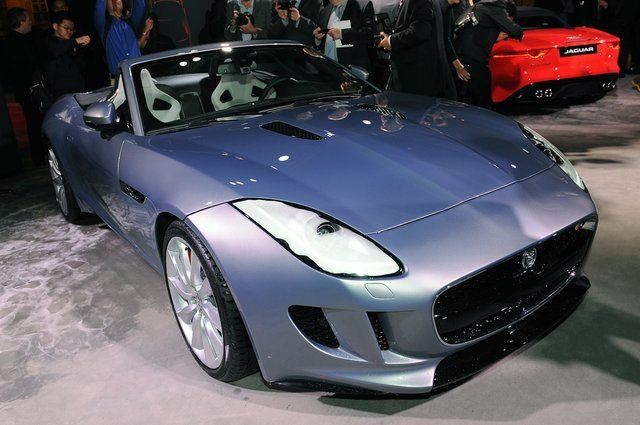Jaguar F-Type Heralds Return Of First New Sports Car For Leaping Cat In 50 Years

Autoblog was invited to England earlier this month for a hush-hush preview of the F-Type, where Jaguar Vehicle Line Director Ian Hoben assured us that "We're not worshipping the ashes of our ancestors here." While Jag has offered the larger XK grand tourer for years, it hasn't really fielded a new sports car in 50 years. And as Hoben points out, "For us not to be there [the segment] seems as wrong as Ferrari or Porsche not building sports cars."
The new all-aluminum F-Type is a strict two-seat affair, none of the leather-wrapped and seatbelt-equipped parcel shelves of the XK here. Available in three trims, F-Type, F-Type S and F-Type V8 S, the baby Jag will offer one of three powertrains, a supercharged 3.0-liter V6 with 340 horsepower and 332 pound-feet of torque, a supercharged 3.0-liter V6 (380 hp / 339 lb-ft.), or a supercharged 5.0-liter V8 (495 hp / 460 lb-ft). The sole transmission at launch will be ZF's ubiquitous eight-speed automatic, with paddles and a more conventional gearshift lever in favor of the rotary selector of recent fame. Jag won't confirm it, but we suspect a manual transmission will be made available in a year's time, possibly on a harder-core R model. In its top specification, Jag promises a 0-100 dash of 4.2 seconds and a limited top speed of 300 km/h. The mid-level V6 S does the deed in 4.8 seconds and taps out at 275 km/h, while the 'base' F-Type still runs to 100 in 5.1 seconds and hits a 259-km/h vMax. While we have yet to drive them, we have heard the new cars fire up and under power, as the Brits say, they sound "right cracking."
Sporting near-perfect 50/50 weight distribution, the rear-drive F-Type is smaller in person than you think – it's actually two centimeters shorter than the Porsche 911, yet is wider and has a significantly longer wheelbase (nearly 17.3 cm). Officials are quick to note that the new aluminum structure is actually stiffer in both torsional and local rigidity than the XK-RS, a convertible with commendable stiffness. Weighing in from as little as 1,597 kg, it's also quite light.
Based upon what we learned, we think the V6 S might actually be the hot ticket for driving enthusiasts – besides having less weight up front (and presumably costing less) than the V8, the V6 S features a mechanical limited-slip differential, while the V8S uses an e-diff solution. Either way, these cars all figure to be good handlers, with the quickest steering rack ever fitted to a Jaguar (14.6 to 1 and still hydraulic to preserve feel) and available active dampers. There's also a dynamic mode accessed through the touchscreen that governs shift points, steering assist and throttle response, along with different intervention thresholds for traction and stability control systems.
And did we mention it's stunning to behold? Drawing heavily from 2011's C-X16 concept, the F-Type's best angle is arguably its rear three-quarter aspect, which has a unique taper and horizontal taillamps that, if anything, reminds vaguely of the BMW Z8. The rump features a deployable rear spoiler so as not to interrupt the vehicle's pretty lines. The profile is particularly clean work thanks to flush-fit door handles that pop open when you touch them, yet there's still a lot of depth, with deep-draw shapes with a lot of "barrel" to them. While we prefer the rear three-quarter view, the front end is no shrinking violet, featuring a bulging, vented clamshell hood and piercing bi-xenon headlamps with the obligatory LED daytime running lamps.
The cabin is based on what Jag is calling a "1+1" philosophy – that's apparently designer-ese for a driver-oriented cockpit with an asymmetric center stack featuring a prominent grab handle. Jaguar design boss tells Autoblog that keeping a low dash out to preserve a roadster-like feel and good visibility was fundamental, so they took the unusual step of creating active center air vents that deploy when the HVAC system deems it is necessary, disappearing from view entirely when not. It's a bit of theater that reminds us of the XF's spinning air vents – whether sports car buyers find it clever or fussy will be interesting to follow. There's also no wood inside – as Ian Callum, Director of Design, reminded us, "The only wood inside of an E-Type was the steering wheel."
Jaguar is taking an unusual approach in placing the F-Type in the sports car market, effectively splitting the market by offering a model priced above competitors like the BMW Z4 and Porsche Boxster, but below the aforementioned 911 and Aston Martin V8 Vantage.


